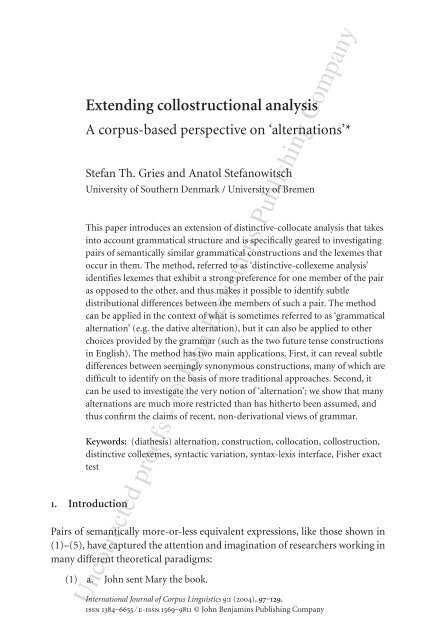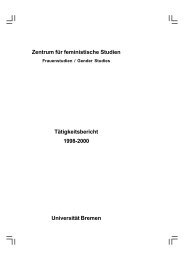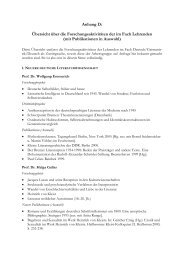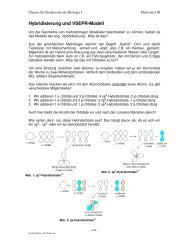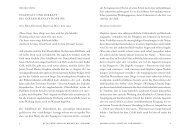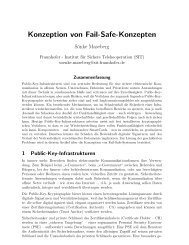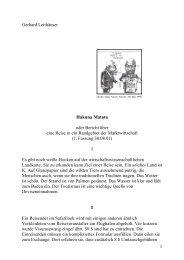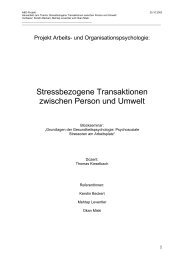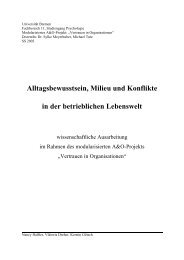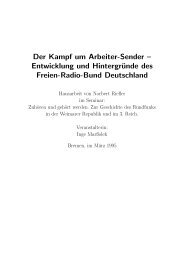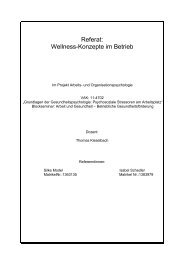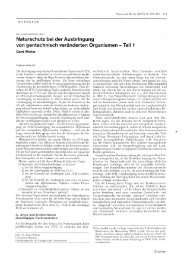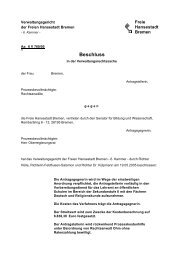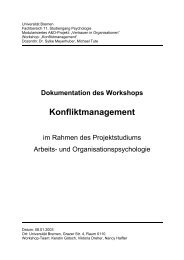Extending collostructional analysis - www-user
Extending collostructional analysis - www-user
Extending collostructional analysis - www-user
Create successful ePaper yourself
Turn your PDF publications into a flip-book with our unique Google optimized e-Paper software.
<strong>Extending</strong> <strong>collostructional</strong> <strong>analysis</strong><br />
A corpus-based perspective on ‘alternations’*<br />
Stefan Th. Gries and Anatol Stefanowitsch<br />
University of Southern Denmark / University of Bremen<br />
This paper introduces an extension of distinctive-collocate <strong>analysis</strong> that takes<br />
into account grammatical structure and is specifically geared to investigating<br />
pairs of semantically similar grammatical constructions and the lexemes that<br />
occur in them. The method, referred to as ‘distinctive-collexeme <strong>analysis</strong>’<br />
identifies lexemes that exhibit a strong preference for one member of the pair<br />
as opposed to the other, and thus makes it possible to identify subtle<br />
distributional differences between the members of such a pair. The method<br />
can be applied in the context of what is sometimes referred to as ‘grammatical<br />
alternation’ (e.g. the dative alternation), but it can also be applied to other<br />
choices provided by the grammar (such as the two future tense constructions<br />
in English). The method has two main applications. First, it can reveal subtle<br />
differences between seemingly synonymous constructions, many of which are<br />
difficult to identify on the basis of more traditional approaches. Second, it<br />
can be used to investigate the very notion of ‘alternation’; we show that many<br />
alternations are much more restricted than has hitherto been assumed, and<br />
thus confirm the claims of recent, non-derivational views of grammar.<br />
Keywords: (diathesis) alternation, construction, collocation, collostruction,<br />
distinctive collexemes, syntactic variation, syntax-lexis interface, Fisher exact<br />
test<br />
1. Introduction<br />
Pairs of semantically more-or-less equivalent expressions, like those shown in<br />
(1)–(5), have captured the attention and imagination of researchers working in<br />
many different theoretical paradigms:<br />
(1) a. John sent Mary the book.<br />
International Journal of Corpus Linguistics 9:1 (2004), 97‒129.<br />
issn 1384‒6655 ⁄ e-issn 1569‒9811 © John Benjamins Publishing Company<br />
Uncorrected proofs - © John Benjamins Publishing Company
98 Stefan Th. Gries and Anatol Stefanowitsch<br />
b. John sent the book to Mary.<br />
(2) a. Picasso painted this picture.<br />
b. This picture was painted by Picasso.<br />
(3) a. John picked up the book.<br />
b. John picked the book up.<br />
(4) a. the university’s budget<br />
b. the budget of the university<br />
(5) a. John will send Mary a book.<br />
b. John is going to send Mary a book.<br />
Some of these pairs, like the ones in (1)–(3) (and to some degree (4)) have<br />
played, and continue to play, an important role in the development of both<br />
formal and functional theories of language structure, while others, like (4) and<br />
(5), have a firm place among those areas of English grammar that are deemed<br />
worthy of detailed discussion in learner grammars of English. Pairs like those<br />
in (1)–(4), which we will refer to as alternating pairs, are typically discussed<br />
in terms of the formal, functional and/or semantic similarities and differences<br />
between their members.<br />
Early transformational grammar and most of its modern descendants are<br />
concerned with the formal relationship between the members of such a pair,<br />
including sometimes the shared semantic restrictions on corresponding slots.<br />
This relationship is typically captured in terms of some derivational mechanism<br />
(such as a transformational rule) relating both members of a pair to the<br />
same underlying structure (cf. Chomsky 1957; Lees 1960 for early examples).<br />
In contrast, discourse-functional approaches have focused on functional<br />
differences between the two members, notably, the different ways in which<br />
they package information flow. Such approaches typically postulate general<br />
linear precedence principles concerning notions like topicality, thematicity,<br />
givenness, or animacy, and set out to show that speakers choose one or the<br />
other variant depending on which one allows them to package the content<br />
that they want to express in accordance with these principles (cf. e.g. Givón<br />
1993: esp. Ch. 11). The formal properties of the alternating pair in question are<br />
usually not addressed explicitly in these approaches, nor is the nature of the<br />
relationship between its two members.<br />
More modern generative approaches, while still interested in the formal<br />
properties of these alternating pairs, focus mainly on the question which of<br />
the two members of a pair represents the ‘basic argument structure’ of a given<br />
Uncorrected proofs - © John Benjamins Publishing Company
Collostructional <strong>analysis</strong> and ‘alternations’ 99<br />
verb (or, in the case of the alternating pair in (4), a given head noun) and<br />
the question what semantic conditions determine whether a given word can<br />
undergo the change in argument structure that is necessary for it to occur in<br />
the ‘non-basic’ member (such changes are sometimes described in terms of<br />
‘lexical rules’) (cf. e.g. Pinker (1989), Levin (1993), see also Fisher, Gleitman &<br />
Gleitman (1991)).<br />
Semantic considerations also play a fundamental role in recent constructionbased<br />
approaches to language, which have dispensed completely with the notion<br />
of positing one of the members of an alternating pair as basic and the<br />
other as derived, or deriving both from the same underlying source. Grammar<br />
is seen as a repository of linguistic signs (i.e. pairings of form (in this<br />
case, grammatical structures) and meaning) which are referred to as ‘constructions’<br />
(Fillmore (1985), Lakoff (1987), Langacker (1987), Goldberg (1995), cf.<br />
also Stefanowitsch & Gries (2003)). In these approaches, each member of an<br />
apparent ‘alternation’ is a construction in its own right (Langacker 1991: Section<br />
11.1 and Goldberg 2002); they appear to ‘alternate’ only because they are<br />
in a partial paraphrase relationship when used with certain lexical items (see<br />
esp. Goldberg (2002), who argues forcefully for this position, and shows that a<br />
construction containing a given verb shares more semantic and syntactic properties<br />
with constructions of the same kind containing different verbs than with<br />
the other construction of the alternating pair containing the same verb). In this<br />
approach, there is no fundamental difference between pairs like those in (1)–<br />
(4) and that in (5), which is why we will extend the term alternating pair to<br />
the latter.<br />
In construction-based approaches, the question whether a given verb/noun<br />
may occur in one or both members of an alternating pair is seen in terms of semantic<br />
compatibility. A verb may occur in a given construction if its meaning<br />
is compatible with the meaning of the construction; it may ‘alternate’ between<br />
two constructions if (or to the degree that) the verb’s meaning is compatible<br />
with the meanings of both constructions. In the context of alternating pairs,<br />
a focus on constructional semantics and semantic compatibility raises several<br />
questions: first, what exactly are the (often seemingly tenuous) semantic differences<br />
between the members of such a pair; second, how productive is the<br />
‘alternation’ in actual usage, i.e. which verbs/head nouns occur freely in both<br />
constructions, and which have strong biases towards one of them; and third,<br />
is a constructional, non-derivative approach plausible given the answers to the<br />
first two questions. We believe that a method that extends the notion of distinctive<br />
collocates in the context of our previously proposed ‘<strong>collostructional</strong><br />
Uncorrected proofs - © John Benjamins Publishing Company
100 Stefan Th. Gries and Anatol Stefanowitsch<br />
<strong>analysis</strong>’ may provide answers to these questions. Section 2 will present this<br />
method, and Section 3 will apply it to the alternating pairs in (1)–(5) above.<br />
Section 4 will discuss some fundamental methodological issues.<br />
2. Distinctive collexeme <strong>analysis</strong><br />
It is widely agreed in corpus linguistics that the linguistic context of a given<br />
word (or phrase) holds important clues to its semantic and syntactic properties,<br />
and thus the <strong>analysis</strong> of this context is a fundamental aspect of corpuslinguistic<br />
research. One way of analyzing a word’s typical contexts is by extracting<br />
its collocates, where collocates are simply defined as ‘words that occur (with<br />
a frequency that is significantly above chance-level) in a given span around the<br />
node word’. The span may vary in size; for example, it is ±1 in Kennedy’s (1991)<br />
investigation of between and through, ±3 in Stubbs’ (1995) semantic <strong>analysis</strong><br />
of the verb cause, and±5 words in Church and Hanks’ (1990) <strong>analysis</strong> of doctor.<br />
In other words, the co-occurrence of words is investigated from a purely<br />
linear perspective on language that deliberately disregards syntactic structure.<br />
The studies in question assume that the noise created by this strategy can be<br />
filtered out by statistical methods, or even that relevant collocates will simply<br />
outnumber non-relevant ones. These assumptions have provided corpus<br />
linguists with intriguing data that has often led to interesting results, but the<br />
deliberate disregard of syntactic structure limits the usefulness of the method<br />
for fine-grained syntactic description (apart from limiting its credibility with<br />
syntactic theorists). In particular, the method is of limited use in the <strong>analysis</strong><br />
of the relationship between lexical items and individual constructions or alternating<br />
pairs such as those discussed above. In recent work, we have combined<br />
collocate <strong>analysis</strong> with a close attention to the syntactic and semantic structures<br />
in which words occur in order to arrive at noise-free data that allow a<br />
much more fine-grained <strong>analysis</strong> of the dependencies and interactions between<br />
single words and grammatical constructions (cf. Stefanowitsch & Gries 2003),<br />
or between different words in a given grammatical construction (cf. Gries &<br />
Stefanowitsch, forthcoming).<br />
This procedure, which we refer to as <strong>collostructional</strong> <strong>analysis</strong> (a blend of<br />
construction and collocational), can be extended to the <strong>analysis</strong> of alternating<br />
pairs of constructions and their relative preferences for words that can (or<br />
should be able to) occur in both of them. The logic behind this extension is basically<br />
that of Church et al.’s (1991) distinctive collocate <strong>analysis</strong>, which uses a<br />
Uncorrected proofs - © John Benjamins Publishing Company
Collostructional <strong>analysis</strong> and ‘alternations’ 101<br />
variant of the t-test as a measure of dissimilarity of semantically similar words<br />
on the basis of their lexical collocates (for example, Church et al. show how<br />
their t-test can identify collocates that distinguish between the adjectives strong<br />
and powerful).<br />
We propose a similar method for the <strong>analysis</strong> of alternating pairs, differing<br />
from Church et al. in that we look at near-synonymous (or functionally<br />
near-equivalent) constructions rather than words, and that we focus on words<br />
appearing in particular slots in these constructions rather than at all words in<br />
a given span (we refer to such words as collexemes of the construction(s) in<br />
question). 1<br />
A variety of measures has been proposed to determine association strengths<br />
(for example, the t-test just mentioned as well as Berry Rogghe’s (1974) z-score,<br />
Church & Hanks’s (1990) pointwise mutual information or Dunning’s (1993)<br />
log-likelihood coefficient). In principle, any of these could be applied in the<br />
context of distinctive collexeme <strong>analysis</strong>, but they are problematic in several<br />
ways. First, they often involve distributional assumptions – specifically, normal<br />
distribution and homogeneity of variances – that are hardly ever justified when<br />
dealing with natural language data (e.g. the z-score and the t-score). Second,<br />
they tend to strongly overestimate association strengths and/or underestimate<br />
the probability of error when extremely rare collocations are investigated (esp.<br />
MI). Even the non-parametric log-likelihood coefficient proposed by Dunning<br />
(1993), which is an improvement over parametric statistics, relies on the Chisquare<br />
distribution for significance testing and is, thus, unreliable given the<br />
kind of extremely sparse data frequently encountered in corpus-linguistic tasks<br />
(cf. Manning & Schütze (2000:175, Note 7), Weeber, Vos, & Baayen (2000) and<br />
Gries (2003c) for examples). This unreliability with respect to rare collocations<br />
is particularly problematic in the case of collostructions, since the vast majority<br />
of collexemes occurring within any given construction have a very low<br />
frequency in that construction (cf. Stefanowitsch & Gries (2003)).<br />
In order to avoid these problems, we will use the Fisher exact test (cf. Pedersen<br />
1996), which is not subject to such theoretical and/or distributional shortcomings.<br />
As an exact test, it does not make any distributional assumptions<br />
and, therefore it does not require any particular sample size. Its only disadvantage<br />
is that a single test may require the summation of thousands of point<br />
probabilities, making it a computationally extremely intensive test procedure.<br />
Let us demonstrate our methodology, which we will refer to as distinctivecollexeme<br />
<strong>analysis</strong>, by means of one of the best known alternating pairs, the socalled<br />
‘dative alternation’, i.e. the alternating pair consisting of the ditransitive<br />
Uncorrected proofs - © John Benjamins Publishing Company
102 Stefan Th. Gries and Anatol Stefanowitsch<br />
construction and the prepositional dative with to, as exemplified in (1) above<br />
and repeated here as (6):<br />
(6) a. Ditransitive: John sent Mary the book.<br />
b. To-dative: John sent the book to Mary.<br />
There is a number of verbs that occur in both of these constructions, which<br />
may lead us to assume that the two constructions are semantically equivalent<br />
(this is, of course, the reason why linguists think of them as an ‘alternation’ in<br />
the first place). However, there is also a number of differences between the two<br />
constructions in terms of the semantic restrictions they place on the verbs and<br />
NPs that can occur in them. An <strong>analysis</strong> of the verbs that are distinctive for each<br />
construction (i.e. that distinguish it significantly from the other) may help us<br />
elucidate the existence and degree of fine semantic differences between the two<br />
that might, in turn, explain the different restrictions.<br />
In order to calculate the distinctiveness of a given collexeme, we need<br />
four frequencies: the lemma frequency of the collexeme in construction A,<br />
the lemma frequency of the collexeme in construction B, and the frequencies<br />
of construction A and construction B with words other than the collexeme<br />
in question. These can then be entered in a 4-by-4 table and submitted to<br />
the Fisher exact test (or any other distributional statistic). Obviously, defining<br />
what counts as an instance of construction A and construction B may<br />
involve decisions on the part of the researcher that have to be justified on<br />
theoretical grounds.<br />
Table 1 shows the frequencies required for a distinctive collexeme <strong>analysis</strong><br />
of the verb give in the ditransitive and the to-dative (for expository purposes,<br />
it also gives the expected frequencies for each combination of verb and construction<br />
in parentheses). The figures in italics were derived from a corpus (the<br />
ICE-GB, see further below), the other figures are the results of additions and<br />
subtractions.<br />
The p-value resulting from the computation of Fisher exact for this distribution<br />
is exceptionally small: p = 1.84E-120. This tells us that the verb give is<br />
Table 1. The distribution of give in the ditransitive and the to-dative (in the ICE-GB)<br />
give Other verbs Row totals<br />
Ditransitive 461 (213) 574 (822) 1,035<br />
To-dative 146 (394) 1,773 (1,525) 1,919<br />
Column totals 607 2,347 2,954<br />
Uncorrected proofs - © John Benjamins Publishing Company
Collostructional <strong>analysis</strong> and ‘alternations’ 103<br />
highly distinctive for one of the two constructions, but it does not tell us for<br />
which one. In order to determine this, we need to compare the observed frequencies<br />
with the expected frequencies. As the expected frequencies provided<br />
in parentheses show, give occurs more than twice as often in the ditransitive and<br />
less than half as often in the to-dative than would be expected given a random<br />
distribution. Thus, although give occurs in both constructions, it is highly distinctive<br />
for the ditransitive (in fact, as we will show below it is the most distinctive<br />
collexeme). Of course, this finding in isolation tells us relatively little about<br />
the semantics of the two constructions; the potential of the present methodology<br />
unfolds only when we repeat the <strong>analysis</strong> for all verbs occurring in the two<br />
constructions and rank them according to their distinctiveness value. 2<br />
3. Case studies<br />
In the following sub-sections, we will apply distinctive-collexeme <strong>analysis</strong> as<br />
described in the previous section to five well-known and much investigated alternating<br />
pairs and show how the results of such an <strong>analysis</strong> bear on some of the<br />
issues discussed with respect to each of the alternating pairs in the literature,<br />
with a focus on the issues raised at the end of Section 1.<br />
All studies are based on the British component of the International Corpus<br />
of English (ICE-GB), a corpus manually annotated for parts of speech, grammatical<br />
relations, syntactic (tree) structure and a variety of morphosyntactic<br />
features such as tense, aspect, mood, voice, transitivity etc. In each case, the<br />
formal configuration of morphosyntactic elements corresponding to the construction<br />
in question was extracted from the corpus with the help of a grep<br />
tool, making full use of the grammatical markup provided. In some cases, this<br />
was an entirely straightforward matter. For example, all ditransitive clauses in<br />
the ICE-GB are annotated as and, thus, could be extracted in a single<br />
pass; the markup of ICE-GB allowed a similarly straightforward extraction of<br />
verb-particle constructions, actives and passive, the will-future and the goingto<br />
future and the s-genitive and the of-genitive. Only in one case, heavy manual<br />
post-editing was necessary: in order to extract the to-dative, we searched for all<br />
clauses containing a direct object and a PP with to (for actives) and all clauses<br />
containing a verb annotated as and containing a PP with to for passives.<br />
Obviously, this search found all instances of the to-dative, but it also turned up<br />
a vast number of false positives which had to be manually discarded, for example,<br />
clauses with purpose or true locative adverbials. Both authors edited the<br />
Uncorrected proofs - © John Benjamins Publishing Company
104 Stefan Th. Gries and Anatol Stefanowitsch<br />
search results independently to ensure maximum accuracy. 3 Thus, for all of the<br />
constructions considered here, we can be sure to have identified all occurrences<br />
(barring annotation errors).<br />
Once we had retrieved all instances of the alternating pair under investigation,<br />
the collexeme tokens (i.e. the words occurring in the slot under investigation)<br />
were lemmatized, and the frequency of each lemma was determined.<br />
The frequencies for each word were cross-tabulated with the frequencies of the<br />
constructions as shown in Table 1 above and submitted to the Fisher exact test<br />
(Fisher exact p-values were computed using the dhyper function in the current<br />
version of R). Finally, the words were ranked according to their Fisher-exact<br />
value for each of the two constructions depending on the direction in which<br />
they deviated from the expected frequency.<br />
3.1 The dative alternation<br />
Let us begin with what is probably the most widely discussed case of<br />
constituent-order alternation in English, the dative alternation already mentioned<br />
in the previous section (i.e. ditransitive construction in (7)a and the<br />
to-dative construction in (7)b; note that in this paper, we are not concerned<br />
with the prepositional dative with for):<br />
(7) a. [SUBJagent VOBJrecipient OBJtheme]<br />
e.g. John sent Mary the book.<br />
b. [SUBJagent VOBJtheme to-ADVrecipient]<br />
e.g. John sent the book to Mary.<br />
This alternating pair has spawned a vast body of research concerned with the<br />
formal, functional, and semantic issues discussed in Section 1.<br />
First, a number of studies in the transformational-generative tradition have<br />
tried to determine which of the two constructions is basic and which is derived;<br />
in these studies, the two constructions are seen as purely syntactic alternatives<br />
that are semantically and pragmatically equivalent (see, for example, Fillmore<br />
(1965), who considers the prepositional dative the basic form from which the<br />
ditransitive is derived transformationally, or Burt (1971), who argues in favor<br />
of the opposite transformational direction).<br />
Second, a number of functional or performance-oriented studies have argued<br />
that information structure is the primary factor determining the choice<br />
between the two constructions, claiming that speakers choose a member of the<br />
alternating pair based on whether its postverbal arguments, in a given context,<br />
Uncorrected proofs - © John Benjamins Publishing Company
Collostructional <strong>analysis</strong> and ‘alternations’ 105<br />
best adhere to linear-precedence principles related to topicality (e.g. Erteschik-<br />
Shir 1979:443, 449ff.; Thompson 1990:245f.; Goldberg 1995:91ff.) or length<br />
(e.g. Hawkins 1994:213).<br />
Third, and most important for our purposes, a number of studies have focused<br />
on the semantics of the two constructions as the primary determining<br />
factor. For example, Thompson and Koide (1987:400) claim that the ditransitive<br />
is used where the distance between agent and recipient is small, and the<br />
to-dative where this distance is large (in their view, this distance is iconically<br />
reflected in the distance between the subject of the construction and the argument<br />
encoding the recipient – the first object in the ditransitive, and the<br />
to-adverbial in the to-dative). Other researchers have posited different constructional<br />
semantics for the two constructions (e.g. Goldberg 1995: Section<br />
2.3.1, Chapters 5–7; Pinker 1989), claiming that the ditransitive means something<br />
like ‘X causes Y to receive Z’ and the to-dative something like ‘X causes Z<br />
to move to Y’, specified by some authors as ‘continuous causation of accompanied<br />
motion’ (Gropen et al. 1989:243f.). Note that the suggested constructional<br />
meanings are fully compatible with the differences in distance between agent<br />
and recipient postulated by Thompson and Koide (1987); ‘causing Y to receive<br />
Z’ does not suggest a long distance between agent and recipient, while ‘causing<br />
ZtomovetoY’does.<br />
The predictions made by these approaches concerning distinctive collexemes<br />
are relatively straightforward: according to purely syntactic or purely<br />
information-structural approaches, one would predict that the two constructions<br />
should not differ at all with respect to their preferred verbs. The semantic<br />
approaches predict that such differences should exist, and that the ditransitive<br />
should prefer verbs of direct face-to-face transfer, while the to-dative should<br />
prefer verbs of transfer over a distance. Consider Table 2, which lists the results<br />
of the distinctive-collexeme <strong>analysis</strong> (to avoid various complications arising<br />
from the fact that there are verbs that do not alternate between the two constructions<br />
under any circumstances, we included only verbs that occur at least<br />
once in each construction in the ICE-GB; we also included only ditransitives<br />
with nominal objects, discarding those with sentential ones).<br />
The results broadly support a semantic approach, in that there clearly are<br />
collexemes distinguishing between the ditransitive and the to-dative. Furthermore,<br />
the specific suggestions concerning the meaning of the two constructions<br />
are largely confirmed. For the ditransitive, we find that give is the most distinctive<br />
collexeme, a verb that matches the proposed constructional semantics of<br />
‘causing to receive’ perfectly (note also that give is the strongest overall collex-<br />
Uncorrected proofs - © John Benjamins Publishing Company
106 Stefan Th. Gries and Anatol Stefanowitsch<br />
Table 2. Collexemes distinguishing between the ditransitive and the to-dative<br />
Ditransitive (N=1,035) To-dative (N=1,919)<br />
Collexeme Distinctiveness Collexeme Distinctiveness<br />
give (461:146) 1.84E-120 bring (7:82) 1.47E-09<br />
tell (128:2) 8.77E-58 play (1:37) 1.46E-06<br />
show (49:15) 8.32E-12 take (12:63) 0.0002<br />
offer (43:15) 9.95E-10 pass (2:29) 0.0002<br />
cost (20:1) 9.71E-09 make (3:23) 0.0068<br />
teach (15:1) 1.49E-06 sell (1:14) 0.0139<br />
wish (9:1) 0.0005 do (10:40) 0.0151<br />
ask (12:4) 0.0013 supply (1:12) 0.0291<br />
promise (7:1) 0.0036 read (1:10) 0.0599<br />
deny (8:3) 0.0122 hand (5:21) 0.0636<br />
award (7:3) 0.0260 feed (1:9) 0.0852<br />
grant (5:2) 0.0556 leave (6:20) 0.1397<br />
cause (8:9) 0.2131 keep (1:7) 0.1682<br />
drop (3:2) 0.2356 pay (13:34) 0.1809<br />
charge (4:4) 0.2942 assign (3:8) 0.4243<br />
get (20:32) 0.3493 set (2:6) 0.4267<br />
allocate (4:5) 0.3920 write (4:9) 0.4993<br />
send (64:113) 0.4022 cut (2:5) 0.5314<br />
owe (6:9) 0.4369 lend (7:13) 0.5999<br />
lose (2:3) 0.5724<br />
eme for this construction, cf. Stefanowitsch & Gries (2003)). Give and most<br />
other distinctive collexemes encode transactions that involve a direct contact<br />
between agent and recipient; these transactions may be literal (as in the case of<br />
give) or they may be metaphorical, instantiating one of the semantic extensions<br />
postulated by Goldberg (1995: Section 2.3.1). For example,<br />
– tell, teach and ask instantiate the communication as transfer metaphor –<br />
note that in their typical senses these verbs encode interpersonal communication<br />
without an intervening medium;<br />
– show instantiates the perceiving as receiving metaphor – note that it<br />
involves visibility between show-er and show-ee;<br />
– offer, promise instantiate the satisfaction condition extension (i.e. the<br />
satisfaction conditions of the speech acts referred to by these verbs imply<br />
the basic literal meaning);<br />
– deny instantiates the cause not to receive extension etc. (i.e. it is the<br />
negation of the basic literal meaning).<br />
Uncorrected proofs - © John Benjamins Publishing Company
Collostructional <strong>analysis</strong> and ‘alternations’ 107<br />
For the to-dative, we find that bring is the most distinctive collexeme; again, this<br />
verb matches the proposed constructional meaning of ‘(continuously) caused<br />
(accompanied) motion’ perfectly. Bring and other verbs strongly distinctive for<br />
the to-dative, such as take or pass, also involve some distance between agent<br />
and recipient that must be overcome to complete the action denoted by the<br />
verb. Second-ranked play also belongs into this category; its distinctiveness<br />
may seem surprising out of context, but it is due to the large number of uses<br />
in the context of sports commentary, such as Michalichenko plays [the ball] forward<br />
to the halfway line (ICE-GB S2A-014 #145:1), and is thus at least in part<br />
due to the characteristics of the corpus we used.<br />
The suggested constructional meanings do not straightforwardly account<br />
for all differences between the two constructions, however. For example, it is<br />
interesting to note that most commercial transaction verbs, such as sell, supply<br />
and pay are all distinctive for the to-dative rather than the ditransitive –<br />
the only exception to that generalization is cost. This finding would have been<br />
difficult to anticipate since a commercial transaction frame seems to be semantically<br />
more compatible with the ditransitive: it involves a change of possession,<br />
but not necessarily a change of location (consider, for example, the context of<br />
selling a house). On the other hand, one might argue that these verbs typically<br />
involve a movement of the commodity to the buyer or the paid sum to the seller<br />
(contrast cost, which never involves motion, and thus would be expected to occur<br />
in the ditransitive). Such observations may offer a useful starting point for<br />
a more refined <strong>analysis</strong> of the two constructions’ semantics.<br />
In the context of studying alternating pairs of constructions, it may of<br />
course also be useful to look at verbs that are not distinctive for either construction,<br />
i.e. verbs that not only can occur readily in both constructions, but<br />
actually do. In the case of the ditransitive and the to-dative, the verbs which<br />
alternate most freely are lend (7:13), send (64:113), get (20:32) and write (4:9).<br />
Especially for send and write, it is easy to see why these are prime candidates for<br />
a relatively free alternation between the two constructions: when used in either<br />
of the two constructions, their meanings involve both the ‘transfer’ meaning of<br />
the ditransitive and the ‘caused motion’ meaning associated with the to-dative.<br />
In the case of such freely alternating verbs, the specific construal of the events<br />
in question will determine the choice of construction (for example along the<br />
lines suggested by Thompson & Koide 1987).<br />
Uncorrected proofs - © John Benjamins Publishing Company
108 Stefan Th. Gries and Anatol Stefanowitsch<br />
3.2 Active and passive<br />
The most famous alternating pair in English is probably the one consisting of<br />
active and passive voice, as in (8):<br />
(8) a. [SUBJ V OBJ]<br />
e.g. Picasso painted this picture.<br />
b. [SUBJ be V-ed (by-ADV)]<br />
e.g. This picture was painted by Picasso.<br />
Again, the relationship between active and passive has been discussed as a<br />
purely syntactic operation (e.g. in early transformational grammar, cf. Chomsky<br />
1957), or as a way of adjusting the information structure of an utterance<br />
(cf. e.g. Givón 1993:47, who claims that the active voice encodes the typical<br />
case where the Agent is the most topical referent, while the passive voice is used<br />
to place the Patient in the topic position in those cases where the Patient is the<br />
most topical referent). There is no doubt that the adjustment of information<br />
structure is one important function of the passive (cf. also Biber et al. 1999:941;<br />
Huddleston & Pullum 2002:1444), but as the passive does not apply freely to<br />
all syntactically transitive verbs, additional restrictions need to be recognized.<br />
Several studies have shown that these restrictions are largely semantic in nature<br />
(cf. e.g. Bolinger 1975; Rice 1987), but few of these studies have explicitly<br />
characterized the meaning of the passive construction independently of that of<br />
the active transitive construction. One such characterization is given in Pinker<br />
(1989), who defines its meaning as follows (where X is the referent of the passive<br />
subject and Y is the referent of the implicit second core argument, which<br />
may be expressed in a by-phrase):<br />
X is in the circumstance characterized by Y’s acting on it (more generally,<br />
the circumstance for which Y is responsible [. . .]). (Pinker 1989:91)<br />
Again, the predictions made by the different views of the active-passive distinction<br />
with respect to distinctive collexemes are relatively straightforward: if<br />
it is a purely syntactic alternation, or if its function is exclusively one of adjusting<br />
information flow, we would not expect there to be any strong collexemes<br />
(since the verbs in question would occur equally naturally in the active voice<br />
and in the passive voice). If semantics plays a role in the choice of construction,<br />
we would expect there to be semantically motivated classes of distinctive<br />
collexemes. More specifically, if Pinker’s characterization is correct, the activevoice<br />
construction should prefer verbs whose active-voice direct objects are<br />
Uncorrected proofs - © John Benjamins Publishing Company
Table 3. Collexemes distinguishing between active and passive<br />
Collostructional <strong>analysis</strong> and ‘alternations’ 109<br />
Active transitive (N=53,144) Passive (N=11,912))<br />
Collexeme Distinctiveness Collexeme Distinctiveness<br />
have (3957:1) 0 base (9:125) 1.97E-80<br />
think (2319:19) 2.38E-175 concern (28:100) 6.92E-49<br />
get (1929:5) 2.88E-162 use (786:377) 1.74E-31<br />
say (1916:58) 1.99E-101 involve (117:122) 2.38E-30<br />
want (1106:1) 1.76E-96 publish (35:68) 2.37E-26<br />
do (2391:182) 1.20E-62 associate (16:53) 6.21E-26<br />
know (1344:53) 4.53E-62 bear (46:70) 1.19E-23<br />
see (1407:72) 1.71E-54 engage (8:41) 5.23E-23<br />
mean (611:7) 5.78E-44 design (30:56) 1.60E-21<br />
like (503:1) 4.00E-43 confine (1:27) 2.79E-19<br />
try (584:8) 1.45E-40 entitle (1:27) 2.79E-19<br />
hope (269:6) 5.06E-17 relate (17:42) 1.00E-18<br />
believe (294:9) 1.89E-16 deposit (1:22) 1.12E-15<br />
remember (271:8) 1.71E-15 compare (34:45) 1.98E-14<br />
feel (256:11) 2.90E-12 derive (10:29) 3.68E-14<br />
suppose (138:1) 1.93E-11 deal (1:18) 8.32E-13<br />
wish (132:1) 6.23E-11 aim (18:32) 1.34E-12<br />
thank (114:0) 9.49E-11 release (25:35) 5.94E-12<br />
enjoy (135:2) 4.51E-10 attach (20:32) 6.33E-12<br />
ensure (101:0) 1.32E-09 store (11:26) 6.75E-12<br />
not (easily) construable as patients, i.e. stative verbs; in contrast, the passivevoice<br />
construction should prefer verbs encoding actions with a salient and relatively<br />
permanent end-state. Table 3 lists the results of the distinctive-collocate<br />
<strong>analysis</strong> (based on all actives and passives of transitive verbs in the ICE-GB).<br />
The results show that constructional semantics is an influencing factor in<br />
the choice between active and passive voice: again, there are clearly distinctive<br />
collexemes for each. These also support the more specific suggestions discussed<br />
above. With respect to active voice, we find that have is the most distinctive<br />
collexeme; a paradigm case of a stative verb (and a frequently cited example for<br />
a transitive verb that never passivizes in its literal use). The other distinctive<br />
collexemes are also stative verbs; all of them referring to mental or emotional<br />
states. There is a number of verbs that do not fit this characterization; we will<br />
presently return to these.<br />
The distinctive collexemes for the passive construction clearly confirm<br />
Pinker’s characterization, and thus the claim that it is a primarily semantic<br />
construction, on a par with argument-structure constructions like the ditran-<br />
Uncorrected proofs - © John Benjamins Publishing Company
110 Stefan Th. Gries and Anatol Stefanowitsch<br />
sitive or the to-dative. The verbs overwhelmingly encode processes that cause<br />
the patient to come to be in a relatively permanent end state; these end states are<br />
often more naturally encoded by stative passives (as in The results [are] based<br />
on a limited sample of patients (S2A 033: #4:1:A)) than by regular passives (as<br />
in The results were based on a limited number of patients (by the researchers)).<br />
Actually, for some of the verbs in question the end state is so much more salient<br />
than the process that led to it that it is not clear that their passive uses are still<br />
capable of being perceived as passives at all. For example, passive uses of base,<br />
concern, andinvolve may well be felt to be copular constructions containing<br />
deverbal adjectives (cf. in this context Quirk et al.’s (1985: Section 3.74–78)<br />
discussion of their notion of ‘passive gradient’).<br />
Let us briefly return to those verbal collexemes that are distinctive for the<br />
active voice even though they do not fit the majority pattern of stative verbs<br />
(get, say, do, mean, try, thank, ensure). These are like the typical passive verbs<br />
in that they encode actions rather than states, but they are different in that the<br />
actions they encode do not lead to permanent end states. The reason that they<br />
are distinctive for the active voice is thus presumably their incompatibility with<br />
the meaning of the passive. 4<br />
In sum, the distinctive-collocate collexeme <strong>analysis</strong> shows that passive<br />
voice is a construction in its own right with its own specific semantics. It encodes<br />
a situation where the referent of the passive-voice subject has come to<br />
be in some relatively stable end state as a result of someone acting on it. The<br />
distinctive collexemes of the active-voice construction are either action verbs<br />
that do not lead to such end states, or they are states that are not brought about<br />
by someone acting on the entity in this state. The highly dynamic action verbs<br />
thought of as typical for active and passive sentences occur in both constructions<br />
equally frequently, and may thus be typical for both constructions, but<br />
are not distinctive for either of them.<br />
3.3 Verb-particle constructions<br />
Let us now turn to an alternating pair of constructions that, in contrast to the<br />
previous two cases, differ exclusively in the order of constituents – the transitive<br />
verb-particle constructions exemplified in (9):<br />
(9) a. [SUBJ V Particle OBJ]<br />
e.g. John picked up the book.<br />
Uncorrected proofs - © John Benjamins Publishing Company
. [SUBJ V OBJ Particle]<br />
e.g. John picked the book up.<br />
Collostructional <strong>analysis</strong> and ‘alternations’ 111<br />
As with the dative alternation, a number of studies have dealt either with the<br />
issue which of these constructions is basic and which is derived (cf. Legum<br />
1968), or with the factors that motivate speakers to choose one or the other.<br />
With respect to the latter issue, the factors that have been suggested include<br />
those also proposed for the dative alternation and/or the active-passive pair,<br />
i.e. the degree of topicality and the length and of the direct object; in addition,<br />
it has been suggested that the degree of idiomaticity of the transitive<br />
phrasal verb has an influence (cf. Gries 2003a for comprehensive discussion of<br />
all theses variables and their influence). With respect to these three variables, it<br />
has been claimed repeatedly that the order [V Prt OBJ] is preferred with nontopical<br />
and/or long object NPs and with idiomatic verb-particle combinations,<br />
while the order [V OBJ Prt] is preferred with topical and/or short object NPs<br />
and with non-idiomatic (literal or metaphorical) verb-particle combinations,<br />
where the particle denotes the spatial goal or the resultant state of the direct<br />
object’s referent.<br />
While factors like topicality or length of the object would not show up in<br />
a distinctive-collexeme <strong>analysis</strong>, idiomaticity should, as should other semantic<br />
factors that might lead to preferences for individual verb-particle combinations.<br />
Very little is known about whether such preferences exist, but Browman<br />
(1986) suggests they may, showing that up in general and the transitive phrasal<br />
verb pick up in particular prefer the order [V Prt OBJ] (Browman 1986:317).<br />
Thus, the predictions are as before: if we are dealing with a purely syntactic or<br />
information-structural difference, there should be no distinctive collexemes;<br />
if semantic factors (such as idiomaticity) play a role, such collexemes should<br />
exist. Table 4 lists the results of the distinctive-collexeme <strong>analysis</strong>.<br />
The results clearly show an influence of semantics. Beginning with [V Prt<br />
OBJ], even a superficial look at its distinctive verbal collexemes underscores the<br />
relevance of idiomaticity. For example, none of the uses of first-ranked carry<br />
out in the ICE-GB has a literal spatial meaning (as in John carried his dog out);<br />
they can all be paraphrased by perform or execute. The same is true of most<br />
other verbs on the list – the particle does not literally denote the endpoint of a<br />
path for any of them. In a few cases, however, the verb-particle combinations<br />
instantiate metaphorical mappings from the source domain of literal spatial<br />
motion to a more abstract target domain; examples include Abadtimetobring<br />
out a war film (S2B-033 #43:1:A) and The use of large quantities of straw [...]<br />
Uncorrected proofs - © John Benjamins Publishing Company
112 Stefan Th. Gries and Anatol Stefanowitsch<br />
Table 4. Distinctive collexemes for [V Prt Obj] and [V Obj Prt]<br />
V Prt Obj (N=1,251) V Obj Prt (N=1,192)<br />
Collexeme Distinctiveness Collexeme Distinctiveness<br />
carry out (49:1) 9.10E-14 get back (0:18) 2.30E-06<br />
find out (49:5) 3.83E-10 get out (2:21) 1.91E-05<br />
point out (43:3) 4.42E-10 play back (1:12) 0.0013<br />
set up (42:8) 1.06E-06 turn off (2:14) 0.0015<br />
take on (37:7) 4.60E-06 ring up (3:16) 0.0015<br />
build up (18:1) 5.44E-05 get on (0:7) 0.0065<br />
take up (35:9) 8.76E-05 get together (0:7) 0.0065<br />
give up (18:3) 0.0010 get in (4:15) 0.0070<br />
work out (20:4) 0.0011 let down (0:6) 0.0134<br />
set out (10:0) 0.0012 get down (0:5) 0.0275<br />
bring about (10:1) 0.0072 have back (0:5) 0.0275<br />
bring out (12:2) 0.0081 have on (0:5) 0.0275<br />
make out (7:0) 0.0092 play forward (0:5) 0.0275<br />
wipe out (6:0) 0.0179 play out (0:5) 0.0275<br />
play down (6:0) 0.0179 trace back (0:5) 0.0275<br />
cut down (6:0) 0.0179 turn round (0:5) 0.0275<br />
fill in (13:4) 0.0304 phone up (1:7) 0.0300<br />
top up (5:0) 0.0351 send back (1:7) 0.0300<br />
lay down (9:2) 0.0387 take off (4:12) 0.0306<br />
rule out (13:5) 0.0586 take out (15:26) 0.0413<br />
also cuts down the smell (W2B-027 #72:1). In the case of find out and point out,<br />
there is an additional syntactic factor that strengthens their association to [V<br />
Prt OBJ]: they often take that-clauses as objects, which can never occur with<br />
the alternative order.<br />
A look at the distinctive collocates of the alternative order [V OBJ Prt] also<br />
confirms the influence of semantics; as expected, it occurs predominantly with<br />
non-idiomatic verb-particle combinations where the particle denotes a spatial<br />
goal or a result. For example, nearly all instances of first-ranked get back in the<br />
ICE-GB encode situations where the (concrete) referent of the direct object NP<br />
moves to the spatial location referred to by the particle (as in Why did he get the<br />
money back (S1B-005 #61:1:A)); the same holds for second-ranked get out (cf.<br />
[When does the] library shut because I want to get a book out overnight (S1A-069<br />
#224:2:B)) and third-ranked play back (cf. It’s with Vasili Khulkov who plays the<br />
ball back to Galiamin (S2A-010 #2:1:A)). In other cases, such as fourth-ranked<br />
turn off, the particle encodes a resultant state that could be referred to by the<br />
Uncorrected proofs - © John Benjamins Publishing Company
Collostructional <strong>analysis</strong> and ‘alternations’ 113<br />
same particle in other constructions (for example, if you turn something off,<br />
then it is off ). 5<br />
As before, the predictions from the literature do not exhaust an <strong>analysis</strong><br />
based on distinctive collexemes. For example, ring up and phone up constitute<br />
an exception to the general pattern in that they are idiomatic, i.e. their particle<br />
does not describe a spatial goal or resultant state (instead, some authors<br />
have claimed, it conveys a kind of perfective meaning). Given that they are synonyms,<br />
it seems unlikely that their unexpected behavior is an accident; it is<br />
likely that a more detailed investigation of a larger corpus would allow us to<br />
determine whether they are part of a systematic semantically based exception<br />
(note, for example, that they are the only verbs of communication among the<br />
distinct collexemes for either construction).<br />
Finally, let us briefly point out that the technique of distinctive collexemes<br />
can of course also be applied to the particle alone; we then find that out and<br />
up (which, as mentioned, typically receive a relatively abstract, perfective interpretation<br />
in the verb-particle constructions) are significantly distinctive for V<br />
Prt NP whereas back, round, together, forward and through (which retain their<br />
spatial meaning in the verb-particle constructions) are significantly distinctive<br />
for V NP Prt.<br />
3.4 Will vs. be going to<br />
As mentioned in the Introduction, the method of distinctive collexemes is not<br />
restricted to the classic cases of ‘alternation’; it can be applied to any pair of constructions<br />
expressing roughly the same meaning, for example, the two major<br />
future tense constructions in English:<br />
(10) a. [SUBJ will VP]<br />
e.g. John will send Mary a book.<br />
b. [SUBJ be going to VP]<br />
e.g. John is going to send Mary a book.<br />
Unlike the previously discussed cases, the choice between these constructions<br />
has not been a major issue in linguistic theorizing, but it is a recurrent topic in<br />
English student’s grammars, which tend to focus on three differences between<br />
the two: (i) when talking about one’s own future actions, be going to is used<br />
for more planned, ‘premeditated’ actions than will (e.g. Thompson & Martinet<br />
1986:185; Murphy 1986:16); (ii) when talking about future events not involving<br />
oneself, be going to expresses a greater certainty on the part of the speaker<br />
Uncorrected proofs - © John Benjamins Publishing Company
114 Stefan Th. Gries and Anatol Stefanowitsch<br />
Table 5. Collexemes distinguishing between the will and the be going to future<br />
Will (N=3,667) Be going to (N=980)<br />
Collexeme Distinctiveness Collexeme Distinctiveness<br />
see (90:8) 0.0004 say (28:42) 1.12E-12<br />
find (58:4) 0.0015 do (105:68) 2.02E-08<br />
give (69:7) 0.0047 happen (11:15) 4.77E-05<br />
know (34:2) 0.0108 have (126:61) 0.0001<br />
provide (17:0) 0.0177 go (96:48) 0.0004<br />
depend (15:0) 0.0285 win (1:6) 0.0005<br />
want (22:1) 0.0305 stay (8:10) 0.0014<br />
receive (14:0) 0.0361 use (19:14) 0.0045<br />
consider (13:0) 0.0458 buy (2:5) 0.0059<br />
remain (13:0) 0.0458 talk (16:11) 0.0160<br />
become (19:1) 0.0553 show (22:13) 0.0213<br />
finish (12:0) 0.0581 get (84:34) 0.0275<br />
hold (11:0) 0.0736 suggest (1:3) 0.0315<br />
include (11:0) 0.0736 be (664:203) 0.0357<br />
notice (11:0) 0.0736 put (19:11) 0.0362<br />
follow (10:0) 0.0934 invest (0:2) 0.0444<br />
reach (10:0) 0.0934 measure (0:2) 0.0444<br />
need (16:1) 0.0985 perform (0:2) 0.0444<br />
send (21:2) 0.1080 photocopy (0:2) 0.0444<br />
accept (9:0) 0.1184 rehearse (0:2) 0.0444<br />
than will (Thompson & Martinet 1986:185ff.; Murphy 1986:16), and, perhaps<br />
related to this point, (iii) be going to is used for talking about a more immediate<br />
future than will (Thompson & Martinet 1986:185; Murphy 1986:16). Clearly,<br />
none of these factors can straightforwardly be related to particular (semantic<br />
classes of) verbs, and thus they cannot be expected to show up transparently in<br />
the lists of distinctive collexemes. However, some reflex of these factors might<br />
be expected. Table 5 lists the results of the distinctive-collexeme <strong>analysis</strong>.<br />
The most striking difference between the two lists concerns the dynamicity<br />
of the actions and events encoded. The distinctive collexemes for will<br />
are overwhelmingly relatively non-agentive or low-dynamicity actions (find,<br />
receive, hold, finish, reach) including perception/cognition events (see, know,<br />
want, consider, notice, need, accept), or states (depend, remain, become). Only<br />
five of the top 20 collexemes encode dynamic actions (give, provide, include,<br />
follow, send). With be going to, the situation is reversed: only five of the top 20<br />
collexemes encode states or non-agentive actions (have, stay, be, happen, get);<br />
the other fifteen collexemes encode very dynamic actions. A second difference<br />
Uncorrected proofs - © John Benjamins Publishing Company
Collostructional <strong>analysis</strong> and ‘alternations’ 115<br />
concerns the specificity of the actions and events involved: the list for be going<br />
to contains some very specific actions (invest, measure, photocopy), and seems<br />
to encode more specific actions and events than will in general.<br />
In other words, be going to encodes more dynamic and more specific actions<br />
and events than will. The higher specificity (to the extent that it can be<br />
argued to be present) may be related to the greater immediacy and certainty<br />
claimed to be associated with be going to. The higher dynamicity may be related<br />
to the notion of premeditation; more dynamic actions require more effort, and<br />
hence perhaps more planning. However, the results of the distinctive collexeme<br />
<strong>analysis</strong> are interesting even if we do not relate them to previous analyses, but<br />
simply add ‘degree of dynamicity’ as an additional distinguishing factor.<br />
3.5 s-genitive vs. of-construction<br />
Finally, let us turn to a famous alternating pair of constructions at the NP level,<br />
the case of the s-genitive and the so-called of-genitive (or of-construction),<br />
shownin(11):<br />
(11) a. [NPmodifier’s Nhead]<br />
e.g. the university’s budget<br />
b. [DET Nhead of NPmodifier]<br />
e.g. the budget of the university<br />
It has been widely assumed that these two constructions are semantically equivalent<br />
and that their distribution is governed by linear precedence preferences<br />
related to givenness (e.g. Standwell 1982; Osselton 1988; cf. Quirk et al. 1985:<br />
§17.45), animacy (e.g. Jespersen 1949; Hawkins 1981; cf. also Quirk et al. 1985:<br />
§17.39), or a combination of the two (Deane 1987). The basic idea behind<br />
such accounts is that NPs with given/animate referents precede those with<br />
new/inanimate referents, and that therefore the s-genitive is chosen when the<br />
modifier is more given/animate, while the of-construction is chosen when the<br />
head is more given/animate. Determining the givenness status of a noun requires<br />
an assessment of its context, and thus givenness is not amenable to<br />
distinctive-collexeme <strong>analysis</strong>; in contrast, animacy can be read off a wordlist,<br />
and thus is a perfect candidate for this method. As previous studies have<br />
shown that givenness is not a factor anyway (Altenberg 1980; cf. Gries 2002<br />
& Stefanowitsch 1998, 2003), we will focus on animacy here.<br />
The predictions of linear-precedence accounts of s-genitive and of-construction<br />
concerning the two constructions’ distinctive collexemes are straightfor-<br />
Uncorrected proofs - © John Benjamins Publishing Company
116 Stefan Th. Gries and Anatol Stefanowitsch<br />
Table 6. Modifiers in the s-genitive and the of-construction<br />
Genitive mod (N=9,892) Of-construction mod (N=11,103)<br />
Collexeme Distinctiveness Collexeme Distinctiveness<br />
he (1664:0) 0 thing (0:101) 9.17E-29<br />
they (1415:0) 0 war (0:88) 3.82E-25<br />
you (1291:6) 0 life (0:75) 1.58E-21<br />
I (1221:0) 0 time (1:68) 4.62E-18<br />
we (697:0) 2.31E-234 system (2:71) 1.24E-17<br />
she (683:0) 1.50E-229 state (0:50) 1.39E-14<br />
it (790:113) 1.98E-149 work (0:47) 9.47E-14<br />
(781:155) 8.25E-123 force (0:41) 4.38E-12<br />
today (13:0) 5.62E-05 society (1:43) 2.60E-11<br />
mother (19:3) 0.0002 century (0:37) 5.63E-11<br />
BBC (11:0) 0.0003 house (0:34) 3.83E-10<br />
women (11:0) 0.0003 pound (0:33) 7.24E-10<br />
widow (10:0) 0.0005 people (38:122) 8.11E-10<br />
Iraq (22:6) 0.0007 area (0:32) 1.37E-09<br />
Britain (31:14) 0.0026 this (0:32) 1.37E-09<br />
yesterday (11:2) 0.0064 data (0:31) 2.60E-09<br />
Lord (14:4) 0.0081 information (0:31) 2.60E-09<br />
tomorrow (6:0) 0.0109 interest (0:31) 2.60E-09<br />
mum (5:0) 0.0232 that (0:31) 2.60E-09<br />
father (11:4) 0.037 water (0:31) 2.60E-09<br />
boy (4:0) 0.0493 population (0:30) 4.92E-09<br />
IBM (4:0) 0.0493 material (0:27) 3.34E-08<br />
Observer (4:0) 0.0493 scheme (0:27) 3.34E-08<br />
professor (4:0) 0.0493 law (0:26) 6.32E-08<br />
taxpayer (4:0) 0.0493 order (0:25) 1.2E-07<br />
ward: the s-genitive should attract animate modifiers and inanimate heads, and<br />
the associations should be reversed for the of-construction. Table 6 shows the<br />
distinctive collexemes for the modifier position of the two constructions.<br />
Clearly, the prediction is borne out spectacularly. Twenty-two of the top 25<br />
distinctive collexemes for the s-genitive refer to human beings; the pronouns<br />
come out at the top, followed by proper names (which we grouped together as<br />
a single lemma), followed by kinship terms and metonymic references via organizations<br />
(BBC, IBM) orcountries(Iraq, Britain) and other human nouns.<br />
Thethreeexceptionsarethetemporalnounstoday, yesterday, andtomorrow<br />
(we will return to these immediately). The top 25 distinctive collexemes of<br />
the of-construction, in contrast, are mainly made up of abstract nouns and<br />
a few concrete inanimate nouns. There are some directly or metonymically hu-<br />
Uncorrected proofs - © John Benjamins Publishing Company
Table 7. Heads in the s-genitive and the of-construction<br />
Collostructional <strong>analysis</strong> and ‘alternations’ 117<br />
Genitive head (N=10,440) Of-construction head (N=11,982)<br />
Collexeme Distinctiveness Collexeme Distinctiveness<br />
friend (125:8) 3.08E-32 sort (7:253) 3.12E-59<br />
mother (92:0) 2.32E-31 part (22:252) 8.46E-45<br />
father (79:1) 2.20E-25 kind (10:206) 1.04E-43<br />
life (129:22) 2.05E-23 number (27:218) 2.01E-33<br />
mind (77:5) 3.02E-20 end (8:155) 1.06E-32<br />
letter (80:11) 1.33E-16 amount (1:100) 2.40E-26<br />
wife (50:1) 6.57E-16 type (1:90) 1.18E-23<br />
hand (66:9) 5.69E-14 rest (0:57) 2.89E-16<br />
correspondent (43:1) 1.22E-13 matter (0:44) 1.02E-12<br />
husband (38:0) 2.34E-13 member (18:98) 1.42E-12<br />
parent (45:2) 3.52E-13 edge (1:45) 1.20E-11<br />
mum (37:0) 5.04E-13 form (18:92) 2.24E-11<br />
work (76:17) 2.69E-12 piece (4:55) 2.38E-11<br />
colleague (35:1) 4.60E-11 level (7:63) 4.38E-11<br />
eye (51:7) 4.71E-11 example (1:42) 7.40E-11<br />
job (41:3) 5.08E-11 side (21:96) 7.49E-11<br />
foot (36:2) 2.29E-10 range (5:54) 2.35E-10<br />
sister (29:0) 2.31E-10 area (11:70) 2.74E-10<br />
child (37:3) 8.18E-10 middle (0:35) 2.92E-10<br />
speech (31:1) 8.78E-10 group (7:59) 3.55E-10<br />
party (30:1) 1.83E-09 aspect (1:39) 4.54E-10<br />
way (64:17) 2.08E-09 loss (1:38) 8.30E-10<br />
book (56:13) 3.39E-09 series (2:41) 1.40E-09<br />
place (38:5) 1.11E-08 copy (1:36) 2.77E-09<br />
name (79:29) 1.72E-08 nature (5:49) 3.48E-09<br />
man nouns, but these refer to relatively abstract or unspecific categories (state,<br />
society, people, population).<br />
However, with respect to the head nouns, the predictions of the linearprecedence<br />
accounts are not borne out at all. Table 7 lists the distinctive<br />
collexemes.<br />
The distinctive collexemes for the s-genitive are again predominantly animate<br />
nouns. Most of these refer to humans in relation to other humans, either<br />
in the context of kinship (mother, father, wife, husband, etc.),orinthecontext<br />
of social or workplace relations (friend, correspondent, colleague). Some<br />
inanimate nouns occur on this list; these are body parts (hand, eye, foot, and<br />
perhaps mind), nouns referring to events/actions and their results (life, letter,<br />
work, speech), and possessions (book, place, andperhapsname). The distinc-<br />
Uncorrected proofs - © John Benjamins Publishing Company
118 Stefan Th. Gries and Anatol Stefanowitsch<br />
tive collexemes of the of-construction are, again, mainly abstract or inanimate<br />
nouns referring to taxonomic relations (sort, kind, type, example) or parts and<br />
quantities (part, number, end, amount, rest, etc.).Thetwoanimatenounsthat<br />
appear here all fall into the latter group as well (member, group). These results<br />
clearly argue against a linear precedence approach. Instead, they support<br />
semantic accounts, such as those developed in Langacker (1995) and Stefanowitsch<br />
(1998, 2003), which claim that the s-genitive and the of-construction<br />
are actually two semantically distinct constructions. Stefanowitsch (2003) argues<br />
that the s-genitive essentially encodes the kinship/social relations and<br />
possession, and the of-construction encodes taxonomic and meronymic relations.<br />
This also accounts for the seemingly correct predictions of the linearprecedence<br />
accounts with respect to the modifiers: animate nouns are simply<br />
more likely to appear in possessive/kinship relations, while abstract and inanimatenounsaremorelikelytobequantifiedandtaxonomized.Aconstructional<br />
account can also accommodate the exceptional temporal nouns in the<br />
head slot of the s-genitive, which can be argued to be instances of a particular<br />
sub-construction of the s-genitive (cf. Stefanowitsch 2003:440, Note 8).<br />
In sum, the distinctive-collexeme <strong>analysis</strong> of the s-genitive and the ofconstruction<br />
yields solid evidence for previously suggested semantics-based accounts<br />
of these two constructions; they are in a paraphrase relationship only<br />
under very specific circumstances (cf. Stefanowitsch 2003), but the <strong>analysis</strong><br />
presented here shows that such cases play a marginal role in the characterization<br />
of the constructions.<br />
4. Methodological issues<br />
As the case studies in Section 3 have shown, distinctive-collexeme <strong>analysis</strong><br />
yields a substantial number of significantly distinctive collexemes for a range<br />
of alternating pairs, and these distinctive collexemes have a potential to reveal<br />
non-trivial properties of the constructions constituting these pairs. In this section,<br />
we will look at two fundamental properties of the method that we have so<br />
far ignored. First, we will address the question whether the method can serve<br />
as a basis for making above-chance-level predictions about which member of<br />
an alternating pair will be chosen for a particular verb. Second, we will address<br />
the possibility that distinctive collexeme <strong>analysis</strong> is overly sensitive, i.e. that it<br />
produces significantly distinctive collexemes even for alternating pairs where<br />
this would not be plausibly expected.<br />
Uncorrected proofs - © John Benjamins Publishing Company
4.1 The predictive power of distinctive collexeme <strong>analysis</strong><br />
Collostructional <strong>analysis</strong> and ‘alternations’ 119<br />
First, let us look at the degree to which significantly distinctive collexemes predict<br />
which member of an alternating pair native speakers will choose in a situation<br />
where both would be possible. For example, a speaker who is about to<br />
produce an utterance describing the successful manual transfer of an item X<br />
from a person A to another person B might want to use the verb give and must<br />
now choose whether to use the ditransitive or the to-dative; does the fact that he<br />
or she has chosen the verb give suffice as a basis for guessing with above-chance<br />
success which construction he or she will choose?<br />
While many of the previous investigations of this alternating pair have<br />
yielded surprisingly good prediction accuracies (exceeding 80%, cf. Gries<br />
2003a, b), we know of no previous work which took the notion of lexical bias<br />
serious enough to investigate to what degree the constructional choice can be<br />
predicted just on the basis of the verb. In what follows, we will remedy this<br />
oversight for each of the construction pairs discussed in Section 3. The first<br />
pair, the dative alternation, will be discussed in some detail to demonstrate the<br />
procedure.<br />
As mentioned in Section 3.1 above, our study of the dative alternation includes<br />
only those verbs that occur at least once in each construction; the resulting<br />
data base consists of 40 verbs constituting 1,772 tokens of both constructions.<br />
Of these tokens, 1,248 (21 types) have a bias towards the ditransitive (for<br />
951tokens/11types,thisbiasissignificant,for297tokens/10types,itis<br />
not significant). The remaining 524 tokens (19 types) are biased towards the<br />
to-dative (for 337 tokens / 8 types, this bias is significant, for 187 tokens / 11<br />
types, it is not significant).<br />
Thus, 79.8% of all tokens of significantly distinctive collexemes for the ditransitive<br />
did in fact occur in the ditransitive. Likewise, 89% of all tokens of<br />
significantly distinctive collexemes for the to-dative did occur in the to-dative.<br />
That is, if we know that the speaker will use one of the distinctive collexemes,<br />
82.2% of the following constructional choices can be predicted correctly<br />
without including any other (syntactic or pragmatic) factor supposed to govern<br />
the choice between the two constructions; these findings are summarized<br />
in Figure 1.<br />
The accuracy of chance-level predictions (i.e. predictions based on the<br />
overall construction frequencies in the corpus) would have been 65% (since<br />
the to-dative accounts for 65% of all tokens of the alternating pairs; cf. below).<br />
Thus, knowing the verb alone leads to a proportional reduction of error<br />
Uncorrected proofs - © John Benjamins Publishing Company
120 Stefan Th. Gries and Anatol Stefanowitsch<br />
p>.05<br />
297/10<br />
bias towards<br />
ditransitive<br />
1,248/21<br />
1,772 verb tokens / 40 verb types<br />
ditransitives<br />
759/11<br />
p>.05<br />
951/11<br />
p>.05<br />
187/11<br />
prep. datives<br />
192/11<br />
bias towards<br />
to-dative<br />
524/19<br />
ditransitives<br />
37/8<br />
p>.05<br />
337/8<br />
prep. datives<br />
300/8<br />
% of dist. coll. 79.8% 20.2% 11.0% 89.0%<br />
Figure 1. Distribution of verbs in the dative alternation<br />
(PRE) of more than 17%. Table 8 shows the corresponding results for the other<br />
alternating pairs discussed in Section 3, calculated in the same way.<br />
Interestingly, the results are not unequivocal: For three of the constructions,<br />
the distinctive collexemes allow us to predict the choice of construction<br />
above chance – for the active-passive pair and the two future tense constructions,<br />
however, predictions on the basis of distinctive collexemes are actually<br />
inferior to guesses on the basis of the overall construction frequencies with the<br />
significant collexemes. This raises two questions. First, is the technique overly<br />
sensitive in that it (sometimes) picks out words as significantly distinctive for<br />
a given construction that are not associated with that construction strongly<br />
Table 8. Prediction accuracies / PRE scores attained by distinctive collexeme <strong>analysis</strong><br />
alternating pair % of distinctive collexemes accuracy % correct prediction<br />
(precision) (combined) by chance; PRE<br />
ditransitive – prep. dative 79.8 89 82.2 65 17.3<br />
active – passive 95.9 57.9 76.9 81.7 –4.8<br />
V Prt NP – V NP Prt 88.8 81.4 85.9 51.2 34.6<br />
will – be going to 68.3 6 42.5 78.9 –36.5<br />
‘s – of : head 86.5 89.2 87.9 53.4 34.5<br />
‘s – of : modifier 96.6 95.9 96.3 52.9 43.4<br />
Uncorrected proofs - © John Benjamins Publishing Company
Collostructional <strong>analysis</strong> and ‘alternations’ 121<br />
enough to make predictions about their distribution? Second, if this is the case,<br />
does this undermine the validity of the method?<br />
We believe that both questions can be answered in the negative. With respect<br />
to the first question, consider where the accuracy of chance-level predictions<br />
comes from in the first place. It results from a strategy where we simply<br />
choose the more frequent member of a pair of alternating constructions, and<br />
predict for every token of every verb that it will appear in that construction.<br />
For example, there are 1,035 ditransitives and 1,919 to-datives in the ICE-GB,<br />
i.e. the to-dative accounts for 65% of all tokens of the pair. Our chance-level<br />
strategy would be to predict for every verb token that it will occur in the todative;<br />
these predictions will be accurate in 65% of all cases. In other words,<br />
the accuracy of chance-level predictions depends on the difference in frequency<br />
between the two members of the pair. If the two members of a pair are roughly<br />
equally frequent (i.e. entropy is high), chance-level predictions will be relatively<br />
inaccurate (this is the case for the dative alternation, the verb-particle<br />
constructions, and the genitives), and thus leave a wide margin for improvement.<br />
If the two members differ greatly in their frequency (i.e. entropy is low),<br />
chance-level predictions will be relatively accurate (this is the case for the two<br />
futures and the active-passive alternation), and thus there is a low margin for<br />
improvement. In purely quantitative terms, then, predictions based on distinctive<br />
collexemes (or any other non-chance criterion) are more likely to increase<br />
prediction accuracy for the first group of constructions than for the second,<br />
and this is, of course, exactly what we find.<br />
However, in qualitative terms, the chance-level predictions are less telling<br />
even where they are more accurate than predictions based on distinctive collexemes;<br />
note that chance-level predictions are by their very nature extremely lopsided:<br />
they predict correctly for a large number of verb tokens that these will<br />
occur in the more frequent construction. However, they do not predict correctly<br />
for any verb token that it will occur in the less frequent construction.<br />
In other words, they simply ignore the less frequent member of the alternating<br />
pair completely, and thus make predictions that, quantitatively accurate<br />
though they may be, do not shed any light on the alternating pair. 6<br />
With respect to the second question, note that even if the discriminative<br />
potential of some verbs is not high enough to yield a uniformly high predictive<br />
power (for reasons just explained), this does not invalidate the semantic<br />
patterns revealed by the <strong>analysis</strong>, which sometimes tied in nicely with previous<br />
works and sometimes even unearthed hitherto unnoticed generalizations<br />
(cf. Stefanowitsch and Gries (2003) for more examples of such surpris-<br />
Uncorrected proofs - © John Benjamins Publishing Company
122 Stefan Th. Gries and Anatol Stefanowitsch<br />
ing findings). 7 Thus, abandoning the technique just because it cannot predict<br />
constructional choices in all cases would be to throw out the baby with the<br />
bathwater by prematurely dispensing with a technique whose other merits are<br />
quite obvious.<br />
4.2 Validation: Try to vs. try and<br />
Potentially, distinctive-collexeme <strong>analysis</strong> may always yield distinctive collexemes,<br />
even for pairs of constructions where this is not plausibly expected. If<br />
this were the case, it would of course diminish the usefulness of the method<br />
to a certain degree. We therefore need to apply it to an alternating pair where<br />
we would not plausibly expect any distinctive collexemes, either because their<br />
meanings are too close, or because they are of a kind that is not easily reflected<br />
in classes of verbs.<br />
One such pair is the one between the two main complementation patterns<br />
of try,[try to V] and [try and V].<br />
(12) a. Let’s try and keep it simple.<br />
b. Let’s try to keep it simple.<br />
The choice between these two alternatives is often claimed to be mainly stylistically<br />
motivated (cf. e.g. the Oxford English Dictionary, s.v. try). Even where semantic<br />
differences have been proposed, they are very tenuous and of a kind that<br />
we would not expect to be reflected in particular verbs. For example, Nordquist<br />
(1998) argues that [try and V] indicates the speaker’s belief that the agent is unlikely<br />
to be successful in achieving the event encoded in the complement of try,<br />
while [try to V] does not indicate any belief about the likely success of the agent.<br />
As ‘likelihood of success’ is not a notion encoded in individual verbs, we would<br />
not expect this meaning difference to show up in a <strong>collostructional</strong> <strong>analysis</strong><br />
method). Table 9 shows the results of the distinctive-collexeme <strong>analysis</strong>.<br />
As expected, there are almost no distinctive collexemes for this alternating<br />
pair. More precisely, there is only one significantly distinctive collexeme for<br />
each construction: make for [try to V] and get for [try and V]. Furthermore,<br />
even for these, the distinctiveness is weaker by many orders of magnitude than<br />
for the top collexemes of all other alternating pairs discussed here. Finally, the<br />
two distinctive collexemes are not interpretable in the context of the claims<br />
concerning stylistic or semantic differences between the two constructions.<br />
Uncorrected proofs - © John Benjamins Publishing Company
Table 9. Collexemes distinguishing between try to and try and<br />
Collostructional <strong>analysis</strong> and ‘alternations’ 123<br />
Try to (N=103) Try and (N=92)<br />
Collexeme Distinctiveness Collexeme Distinctiveness<br />
make (9:1) 0.0147 get (7:15) 0.0305<br />
do (5:1) 0.1342 come (0:3) 0.1032<br />
put (3:0) 0.1453 teach (0:2) 0.2213<br />
analyse (2:0) 0.2777 show (0:2) 0.2213<br />
give (2:0) 0.2777 learn (0:2) 0.2213<br />
improve (2:0) 0.2777 set (1:2) 0.4575<br />
persuade (2:0) 0.2777 see (1:2) 0.4575<br />
use (2:0) 0.2777 bring (1:2) 0.4575<br />
keep (3:1) 0.3542 be (1:2) 0.4575<br />
absorb (1:0) + next 46 verbs 0.5282 win (0:1) + next 44 verbs 0.4718<br />
5. Conclusion<br />
This paper has introduced an extension of our previously proposed method of<br />
<strong>collostructional</strong> <strong>analysis</strong> specifically geared to investigating distinctive collexemes<br />
for pairs of constructions. This method can be applied in the context of<br />
what is traditionally thought of as ‘alternation’ (e.g. the dative ‘alternation’, particle<br />
‘movement’, or the ‘transformational’ relationship between active and passive),<br />
but it can more generally be applied to any area of grammar where there<br />
is a choice between two more or less equivalent constructions (as in the case of<br />
will-future vs. the be-going-to-future or the s-genitive vs. the of-construction).<br />
This methodology enables us to gain insights on several levels.<br />
First, it allows descriptions of ‘alternation’ phenomena on a sounder empirical<br />
basis and at a finer level of detail than has previously been the case.<br />
These descriptions have uses, for example, in applied linguistics, where they<br />
may serve to structure teaching materials and modern reference works (in the<br />
vein of Biber et al. (1999)). They also have implications for psycholinguistic research<br />
– for example in the context of Stallings et al.’s (1998) ‘verb disposition<br />
hypothesis’, which states that individual verbs have dispositions towards certain<br />
constructions or constructional processes; our method provides a more<br />
sophisticated operationalization of verb disposition than previous studies, in<br />
addition to making it possible to (partially) explain lexical bias effects in the<br />
first place.<br />
Second, our results bear directly on the <strong>analysis</strong> of specific, much-discussed<br />
phenomena of English grammar, where they generally support analyses based<br />
Uncorrected proofs - © John Benjamins Publishing Company
124 Stefan Th. Gries and Anatol Stefanowitsch<br />
on constructional semantics and disconfirm analyses based purely on syntactic<br />
or pragmatic factors (as in the case of the dative alternation, the passive, and the<br />
genitive), or where they show a strong lexical bias of constructional alternatives<br />
to exist in addition to previously discussed syntactic or pragmatic factors (as in<br />
the case of the verb-particle construction or the two future constructions).<br />
Finally, the results obtained by our methodology have consequences for<br />
linguistic theorizing at a more general level; the results show that in some of<br />
the paradigm cases of ‘alternation’, there is clear evidence that each of the two<br />
members of the alternating pair is a construction in its own right with its own<br />
meaning. These meanings may overlap, thus placing the constructions in a partial<br />
paraphrase relationship with each other; still, what is primary are the constructions,<br />
and not the paraphrase relation (cf. Goldberg (2002), Gries (2003a:<br />
Section 7.1.2), Stefanowitsch (2003) for additional arguments for this position,<br />
based on a variety of syntactic, semantic and pragmatic differences between the<br />
constructions involved in some of the classic examples of alternating pairs).<br />
Notes<br />
* The order of authors is arbitrary.<br />
1. Note that the method is not restricted to alternating pairs but can be extended to ‘alternating<br />
triplets’ or any other size set of semantically similar constructions. For example, we<br />
might extend set of the constructions exemplified in (1) above by adding the for-dative or<br />
constructions of the type John{provided/gifted/presented/...}Marywithabook.<br />
2. Note that we use the Fisher exact p-value (i.e. the statistical probability of error) as a<br />
measure of distinctivity. This use of a measure of statistical significance as a measure of<br />
association strength might be objected to; usually, an effect size is used to determine association<br />
strength, and this effect value is then tested for statistical significance. However,<br />
the advantage of the Fisher exact p-value is that it incorporates the size of the effect observed<br />
in any particular cross-tabulation, as well as weighing the effect on the basis of the<br />
observed frequencies. This sensitivity to frequency seems a desirable property when dealing<br />
with natural language data (for example, frequency plays an important role for the degree to<br />
which constructions are entrenched and the likelihood of the production of lexemes in individual<br />
constructions (cf. Goldberg 1999)) (the use of p-values as a measure of association<br />
strength is justified in more detail in Stefanowitsch & Gries (2003), following earlier work<br />
by Pedersen (1996), Pedersen, Banerjee, & Purandare (2003)).<br />
3. A detailed description of the ICE-GB, its design and markup can be found in Greenbaum<br />
(1996).<br />
4. The collexemes in Table 3 could be argued to show an additional influence on the choice<br />
between active and passive, namely that of genre: note that the top distinctive collexemes<br />
Uncorrected proofs - © John Benjamins Publishing Company
Collostructional <strong>analysis</strong> and ‘alternations’ 125<br />
for the passive include a greater number of formal, Latinate verbs than those for the active.<br />
This may be due to the uneven distribution of the actives and passives (as defined by [VP<br />
[V ]]) across the written and the spoken part of the ICE-GB: in the written part, actives<br />
are about 5.5 times more frequent than passives while, in the spoken part, actives are about<br />
13 times more frequent than passives. A more refined distinctive-collexeme <strong>analysis</strong> could<br />
take into account the distribution of the constructions across genres, text types, or even the<br />
constructions dispersion across individual samples in the corpus.<br />
5. An interesting problem is exemplified by have on: a closer look at the context indicates<br />
that the five occurrences in the ICE-GB in fact instantiate two different senses, namely ‘wear<br />
clothes’ (e.g. You have your bra on [S1A-090 #252:2:C]) and ‘conduct’ (e.g. And they having<br />
a bit of a sort of a sale on [S1A-040 #286:1:A]); while in this case the two senses of have<br />
on exhibit the same preference for one construction, this need of course not necessarily be<br />
the case; different (related or unrelated) senses of the same verb may well exhibit different<br />
constructional preferences. Thus, in some cases it might be more precise and rewarding to<br />
not just look at the distinctive collexemes of verbs, but of verb senses,i.e.verb-sensespecific<br />
patterns (cf. Hare, McRae, & Elman (2003) and recent work by Roland and colleagues; cf.,<br />
e.g., Roland & Jurafsky (2002)).<br />
6. For those who prefer a more technical support of the line of reasoning just adopted,<br />
let us briefly evaluate the proposed methodology in terms of a well-established effectiveness<br />
measure, namely F (with precision and recall weighted equally; cf. Manning & Schütze<br />
2000: Section 8.1). Computing all 24 F values (12 constructions predicted according to either<br />
our distinctive-collexeme <strong>analysis</strong> or by raw frequency) shows that the average F-value<br />
following from the distinctive-collexeme <strong>analysis</strong> (0.77) is considerably larger than that of<br />
simply deciding on the basis of the more frequent construction (0.65). Thus, the qualitative<br />
argumentation against simply never predicting the less frequent construction is also<br />
supported quantitatively by the higher tradeoff of precision and recall resulting from our<br />
distinctive-collexeme <strong>analysis</strong>.<br />
7. Given the degree of predictive power of distinctive collexeme <strong>analysis</strong> demonstrated here,<br />
it is intriguing to think about possible applications. For example, as one reviewer has rightly<br />
pointed out, the information yielded by this method might be used to further increase the<br />
naturalness of the output of natural language generation systems especially in combination<br />
with other context features.<br />
References<br />
Altenberg, B. (1980). Binominal NPs in a thematic perspective: Genitive vs. of-constructions<br />
in 17th century English. In S. Jacobson (Ed.), Papers from the Scandinavian Symposium<br />
on Syntactic Variation (pp. 149–172). Stockholm: Almqvist & Wiksell.<br />
Berry-Rogghe, G. L. M. (1974). Automatic identification of phrasal verbs. In J. L. Mitchell<br />
(Ed.), Computers in the Humanities (pp. 16–26). Edinburgh: Edinburgh University<br />
Press.<br />
Uncorrected proofs - © John Benjamins Publishing Company
126 Stefan Th. Gries and Anatol Stefanowitsch<br />
Biber, D., Johansson, S. Leech, G., Conrad, S., & Finegan, E. (1999). Longman Grammar of<br />
Spoken and Written English. London: Longman.<br />
Bolinger, D. (1975). On the passive in English. In A. Makkai & V. Becker Makkai (Eds.), The<br />
First Lacus Forum 1974 (pp. 57–80). Columbia, SC: Hornbeam Press.<br />
Browman, C. (1986). The hunting of the quark: The particle in English. Language and<br />
Speech, 29(4), 311–334.<br />
Burt, M.K. (1971). From Deep to Surface Structure. NewYork:HarperRow.<br />
Chomsky, N. A. (1957). Syntactic Structures. The Hague: Mouton.<br />
Church, K. W., & Hanks, P. (1990). Word association norms, mutual information, and<br />
lexicography. Computational Linguistics, 16(1), 22–29.<br />
Church, K.W., Gale, W., Hanks, P. & Hindle, D. (1991). Using statistics in lexical <strong>analysis</strong>. In<br />
U. Zernik (Ed.), Lexical acquisition: Exploiting On-line Resources to Build up a Lexicon<br />
(pp. 115–164). Hillsdale, NJ: Lawrence Erlbaum.<br />
Deane, P. D. (1987). English possessives, topicality and the Silverstein hierarchy. In J. Aske,<br />
N. Beery, L. Michaelis, & H. Filip (Eds.), Proceedings of the Thirteenth Annual Meeting of<br />
the Berkeley Linguistics Society (pp. 65–76). Berkeley, CA: Berkeley Linguistics Society.<br />
Dunning, T. (1993). Accurate methods for the statistics of surprise and coincidence.<br />
Computational Linguistics, 19(1), 61–74.<br />
Erteschik-Shir, N. (1979). Discourse constraints on dative movement. In T. Givón (Ed.),<br />
Discourse and Syntax: Syntax and Semantics 12 (pp. 441–487). New York, San Diego &<br />
London: Academic Press.<br />
Fillmore, C. J. (1965). Indirect Object Constructions in English and the Ordering of<br />
Transformations. The Hague: Mouton.<br />
Fillmore, C. J. (1985). Syntactic intrusions and the notion of grammatical construction. In<br />
M.Niepokuj,M.VanClay,V.Nikiforidou,&D.Feder(Eds.),Proceedings of the Eleventh<br />
Annual Meeting of the Berkeley Linguistics Society (pp. 73–86). Berkeley, CA: Berkeley<br />
Linguistics Society.<br />
Fillmore, C. J. (1988). The mechanisms of ‘Construction Grammar.’ In S. Axmaker,<br />
A. Jaisser, & H. Signmaster (Eds.), Proceedings of the Fourteenth Annual Meeting of the<br />
Berkeley Linguistics Society (pp. 35–55). Berkeley CA: Berkeley Linguistics Society.<br />
Fisher, C., Gleitman, H., & Gleitman, L. R. (1991). On the semantic content of subcategorization<br />
frames. Cognitive Psychology, 23(3), 331–392.<br />
Givón, T. (1993). English Grammar. A Function-based Approach. Vols1&2.Amsterdam&<br />
Philadelphia: John Benjamins.<br />
Goldberg, A. E. (1995). Constructions: A Construction Grammar Approach to Argument<br />
Structure. Chicago: University of Chicago Press.<br />
Goldberg, A. E. (1999). The emergence of the semantics of argument structure<br />
constructions. In B. MacWhinney (Ed.), The Emergence of Language (pp. 197–212).<br />
Mahwah, NJ: Lawrence Erlbaum.<br />
Goldberg, A. E. (2002). Surface generalizations: An alternative to alternations. Cognitive<br />
Linguistics, 13(3), 327–356.<br />
Greenbaum, S. (Ed.) (1996). Comparing English Worldwide: The International Corpus of<br />
English. Oxford: Clarendon Press.<br />
Uncorrected proofs - © John Benjamins Publishing Company
Collostructional <strong>analysis</strong> and ‘alternations’ 127<br />
Gries, St. Th. (2002). Evidence in linguistics: Three approaches to genitives in English. In<br />
R. M. Brend, W. J. Sullivan, & A. R. Lommel (Eds.), LACUS Forum XXVIII: What<br />
constitutes evidence in linguistics? (pp. 17–31). Fullerton, CA: LACUS.<br />
Gries, St. Th. (2003a). Multifactorial Analysis in Corpus Linguistics: A Study of Particle<br />
Placement. London, New York: Continuum Press.<br />
Gries, St. Th. (2003b). Towards a corpus-based identification of prototypical instances of<br />
constructions. Annual Review of Cognitive Linguistics, 1, 1–28.<br />
Gries, St. Th. (2003c). Testing the sub-test: A collocational-overlap <strong>analysis</strong> of English -ic<br />
and -ical adjectives. International Journal of Corpus Linguistics, 8(1), 31–61.<br />
Gries, St.Th., & Stefanowitsch, A. (forthcoming). Covarying collexemes in the intocausative.<br />
In M. Achard & S. Kemmer (Eds.), Language, Culture, and Mind. Stanford:<br />
CSLI Publications.<br />
Gropen, J., Pinker, S., Hollander, M., Goldberg, R., & Wilson, R. (1989). The learnability<br />
and acquisition of the dative alternation in English. Language, 65(2), 203–257.<br />
Hare, M. L., McRae, K., & Elman, J. L. (2003). Sense and structure: Meaning as a determinant<br />
of verb subcategorization preferences. Journal of Memory and Language, 48(2),<br />
281–303.<br />
Hawkins, J. A. (1994). A Performance Theory of Order and Constituency. Cambridge:<br />
Cambridge University Press.<br />
Hawkins, R. (1981). Towards an account of the possessive constructions: NP’s N and the N<br />
of NP. Journal of Linguistics 17(2), 247–269.<br />
Huddleston, R., & Pullum, G. K. (2002). The Cambridge Grammar of the English Language.<br />
Cambridge: Cambridge University Press.<br />
Jespersen, O. (1949). A Modern English Grammar on Historical Principles, Vol.7:Syntax.<br />
Copenhagen: Munksgaard.<br />
Kennedy, G. (1991). Between and through: The company they keep and the functions they<br />
serve. In K. Aijmer & B. Altenberg (Eds.), English Corpus Linguistics (pp. 95–110).<br />
London: Longman.<br />
Lakoff, G. (1987). Women, Fire, and Dangerous Things. What Categories Reveal about The<br />
Mind. Chicago & London: The University of Chicago Press.<br />
Langacker, R. W. (1987). Foundations of Cognitive Grammar.Vol.1.Theoretical Prerequisites.<br />
Stanford: Stanford University Press.<br />
Langacker, R. W. (1991). Foundations of Cognitive Grammar. Vol.2.Descriptive Application.<br />
Stanford: Stanford University Press.<br />
Langacker, R. W. (1995). Possession and possessive constructions. In J. R. Taylor & R. E.<br />
MacLaury (Eds.), Language and the Cognitive Construal of the World (pp. 51–79). Berlin<br />
& New York: Mouton de Gruyter.<br />
Lees, R. B. (1960). The Grammar of English Nominalizations. The Hague: Mouton.<br />
Legum, S. (1968). The verb-particle construction in English: Basic or derived? In B. J.<br />
Darden, C.-J. Bailey, & A. Davison (Eds.), Papers from the Fourth Regional Meeting<br />
Chicago Linguistic Society (pp. 50–62). Chicago, IL: Chicago Linguistics Society.<br />
Levin, B. (1993). English Verb Classes and Alternations. A Preliminary Investigation. Chicago<br />
& London: The University of Chicago Press.<br />
Uncorrected proofs - © John Benjamins Publishing Company
128 Stefan Th. Gries and Anatol Stefanowitsch<br />
Manning, C. D., & Schütze, H. (2000). Foundations of Statistical Natural Language Processing.<br />
4th printing with corrections. Cambridge, MA: The MIT Press.<br />
Murphy, R. (1986). English Grammar in Use. 4th revised impression. Cambridge: Cambridge<br />
University Press.<br />
Nordquist, D. (1998). Try and: a discourse <strong>analysis</strong>. Proceedings of the First High Desert<br />
Linguistics Society Conference, April 3–4. Albuquerque, NM.<br />
The Oxford English Dictionary. (1989). Second edition, 20 vols. Oxford: Clarendon Press.<br />
Osselton, N. E. (1988). Thematic genitives. In G. Nixon & J. Honey (Eds.), An Historic<br />
Tongue: Studies in English Linguistics in Memory of Barbara Strang (pp. 138–144).<br />
London: Routledge.<br />
Pedersen, T. (1996). Fishing for exactness. Proceedings of the SCSUG 96 in Austin, TX, 188–<br />
200.<br />
Pedersen, T., Banerjee, S., & Purandare, A. (2003). Ngram statistics package 0.53.<br />
http://<strong>www</strong>.d.umn.edu/∼tpederse/code.html (last access: 20 January 2003).<br />
Pinker, S. (1989). Learnability and Cognition: The Acquisition of Argument Structure.<br />
Cambridge, MA: The MIT Press.<br />
Quirk, R., Greenbaum, S., Leech, G., & Svartvik, J. (1985). A Comprehensive Grammar of the<br />
English Language. London: Longman.<br />
Rice, S. A. (1987). Towards a transitive prototype: Evidence from some atypical English<br />
passives. In J. Aske, N. Beery, L. Michaelis, & H. Filip (Eds.), Proceedings of the<br />
Thirteenth Annual Meeting of the Berkeley Linguistics Society (pp. 422–434). Berkeley,<br />
CA: Berkeley Linguistics Society.<br />
Roland, D., & Jurafsky, D. (2002). Verb sense and subcategorization probabilities. In P. Merlo<br />
& S. Stevenson (Eds.), The Lexical Basis of Sentence Processing: Formal, Computational<br />
and Experimental Issues (pp. 303–324). Amsterdam & Philadelphia: John Benjamins.<br />
Stallings, L. M., MacDonald, M. C., & O’Seaghdha, P. G. (1998). Phrasal ordering constraints<br />
in sentence production: Phrase length and verb disposition in Heavy-NP Shift. Journal<br />
of Memory and Language, 39(3), 392–417.<br />
Standwell, G. B. J. (1982). Genitive constructions and functional sentence perspective.<br />
International Review of Applied Linguistics, 20(4), 257–261.<br />
Stefanowitsch, A. (1998). Possession and partition: The two genitives of English. Cognitive<br />
Linguistics: Explorations, Applications, Research, 23. Dept. of English, University of<br />
Hamburg.<br />
Stefanowitsch, A. (2003). Constructional semantics as a limit to grammatical variation. In<br />
G. Rohdenburg & B. Mondorf (Eds.), Determinants of Grammatical Variation in English<br />
(pp. 155–173). Berlin & New York: Mouton de Gruyter.<br />
Stefanowitsch, A., & Gries, St. Th. (2003). Collostructions: On the interaction between verbs<br />
and constructions. International Journal of Corpus Linguistics, 8(2), 209–243.<br />
Stubbs, M. (1995). Collocations and semantic profiles: On the cause of the trouble with<br />
quantitative studies. Functions of Language, 2(1), 23–55.<br />
Thompson, S. A. (1990). Information flow and dative shift in English discourse. In J. A.<br />
Edmondson, C. Feagin, & P. Mühlhäusler (Eds.), Development and Diversity: Language<br />
Variation across Time and Space (pp. 239–253). Dallas: SIL & University of Arlington,<br />
TX.<br />
Uncorrected proofs - © John Benjamins Publishing Company
Collostructional <strong>analysis</strong> and ‘alternations’ 129<br />
Thompson, S. A., & Koide, Y. (1987). Iconicity and ‘indirect objects’ in English. Journal of<br />
Pragmatics, 11(3), 399–406.<br />
Thompson, A. J., & Martinet, A. V. (1986). A Practical English Grammar.4th edition. Oxford:<br />
Oxford University Press.<br />
Weeber, M., Vos, R., & Baayen, R. H. (2000). Extracting the lowest-frequency words: Pitfalls<br />
and possibilities. Computational Linguistics, 26(3), 301–317.<br />
Uncorrected proofs - © John Benjamins Publishing Company


